Methodism in the Conyngham Valley
The initial thrust of Methodism in the Conyngham Valley actually began through the preaching of John Rhodes, a traveling minister who attracted settlers in the Valley from near and far. His preaching took place in a long church just south of the Episcopal cemetery on the site of the present Hazleton Library branch. There was a total of four acres deeded to four trustees by Redmond Conyngham and it wasn’t long before a church building was being planned at the present borough building site. It was a long building where half of the structure was used for preaching while the other half was made into a school house. It could be opened up to use the entire building for special events of the Valley.
The first Methodist Bible Class was formed in this initial building lead by Charles Bowman. A Sunday School was organized by Asher Stout soon after it was built.
Then in 1866, the Church Society built a church in the North part of Conyngham at a cost of $2,500.00. The church lot was donated by Dr. Casselberry of Hazleton and measured approximately 40’ X 50’. At that time, the primary material for construction was wood framing; and the original church was constructed on this site. A short time later, a parsonage was built alongside the church building where the Sunday School met and it was known as the “Lecture Room”. A picture is shown below, be sure to note the dirt streets for horse and wagon travel:

The charter for the Conyngham church is dated 1869 and was part of the old Jeansville Circuit. In 1874 it divided the circuit and Drums, Conyngham and Black Creek was formed into one multi-church charge. By 1880 the Sunday School led by M.F. Boston, Superintendent, boasted 116 total scholars, 16 teachers, and an average weekly attendance of 75; in addition they had a library of 492 volumes. By 1890, they had established an Epworth League of the Methodist Church and adopted a constitution in order to teach the youth of the valley and adults as needed.
The church was updated in the early 1890’s (see picture below):

This brought a more modern look to the Church building and has some of the original Stained Glass windows which are part of the building even today. As time went on, the wooden structures of the past began to deteriorate and the congregation felt a more up-to-date brick structure would be more lasting. Further upgrades to the church building were made in the early 1900’s to make structural improvement, especially to the bell tower / belfry (see below):
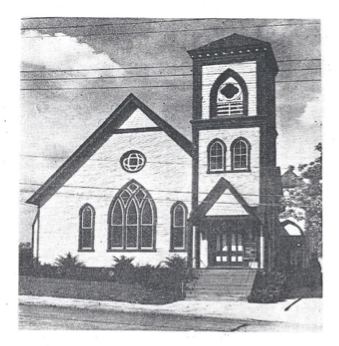
As time went on, the parsonage began to deteriorate badly and was torn down leaving only the original church building itself standing with a parking lot to the north side of the church and behind it. Realizing that there were limited facilities to meet with youth and adult teaching classes let alone those wonderful church dinners, the congregation pondered what would be an appropriate resolve to make the church more available to the community.
On September 21, 1958, a Worship and Ground-Breaking Service was held for a new church school building with an anticipated cost of $90,000.00. Officers of the church included Rev. Ray Deming, Pastor; Mr. George Kay, Lay Leader; Harold E. Smith, Trustee Chairperson; Mrs. Ann Faux, WSCS; Dale Wolfe and Paula Young, MYF. Consecration took place on June 14, 1959.
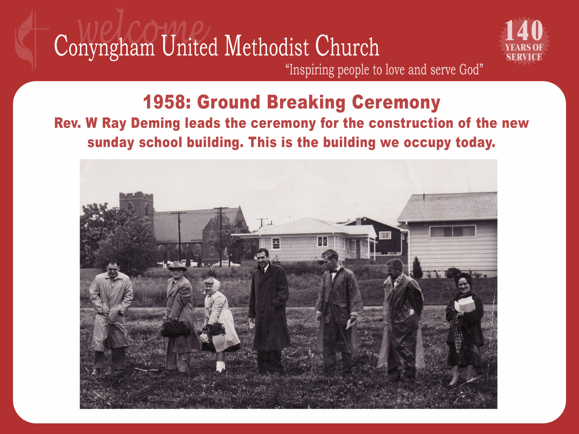
The completion of the Sunday School building provided valuable space for the ministries of the church over many years, while the original church structure provided a place for worship. However, the longer that time went on, the more deteriorated the original Sanctuary became… and in 1969 it was the 100th year anniversary of our Methodist charter. By 1980, besides significant dollars being spent to improve the building itself, it was pointed out that the Sanctuary had become structurally deficient and if something was not done, worship would be restricted to the Sunday School building. It was noted that you could stick a pencil completely into the foundation walls and remove it without difficulty. Therefore, in 1980, the congregation voted to completely raze the building & foundation. The cost of building a new structure was prohibitive to the congregation and would have caused difficulty in repaying the debt service requirements.
In the spring of 1981, Joe Racho, a well-known member of the congregation, created a design which called for using a portion of the present Sunday School building as a foundation to build a new Sanctuary for worship. The cost of the renovation would be more reasonable than new construction; keeping costs to around $125,000.00 thanks to the efforts of countless contributions of time, materials, and money from members and non-members alike of the church. The plans incorporated both new construction and memorabilia of the original Sanctuary in order to maintain the Methodist heritage from the past.
The last service was held in the original church Sanctuary on July 12, 1981 and the building sat empty for a period of time until the congregation could make a determination of what to do with it. Bids went out to contractors for the dismantling of the original building and the removal of any debris. All of the bids were significantly high except for one from an individual from the McAdoo area which came in around $15,000.00. In an interview, he shared with the church that he would be doing the demolition himself, preserving as much of the wood from the structure as possible and sending it to South American for inclusion in construction there in the future. The only thing he asked is for an extended period of time to complete the demolition and removal since he was working himself on the project. Due to the price and the fact that the wood would be reused in other projects, the congregation gave him about a 3 month period for completion. A picture of the demolition in progress is seen below:
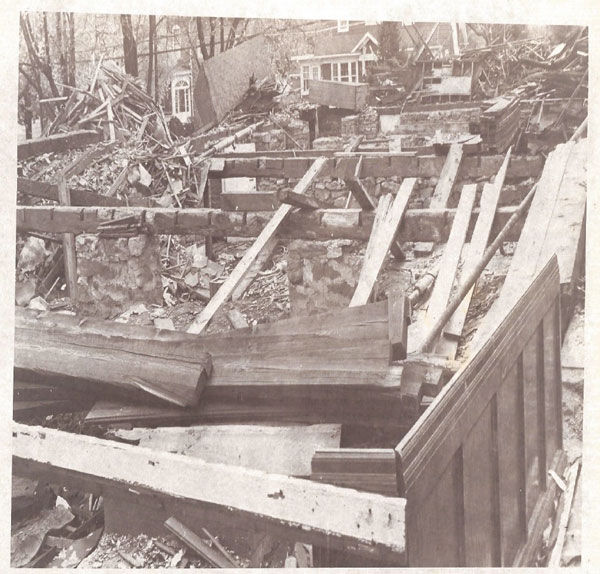
Although everything was initially going quite well, that timetable was adjusted part-way through the demolition period when the individual contractor fell off a ladder and broke his leg. That really meant further delays were necessary in order to complete the entire project. Although concerned, the contractor was able to complete the demolition very close to the original time-line established for completion. The entire area was paved for parking when possible.
Today as you enter the Sanctuary, you would see the ‘storied’ GOD IS LOVE stained glass window over the altar, from the original Sanctuary.
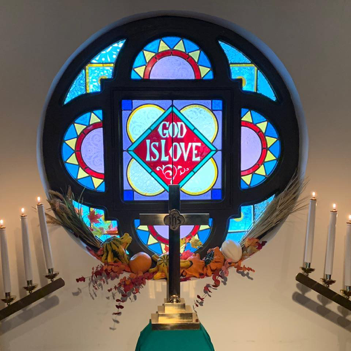
Many of the stained glass windows were preserved from the original Sanctuary, along with the pews and the large hanging lights in the rear of the church. One can’t help but notice the Bell Tower outside the Sanctuary building which houses the original church bell from 1893 presented by Dr. F. M. Brundage in his daughter’s name, Clara Brundage.
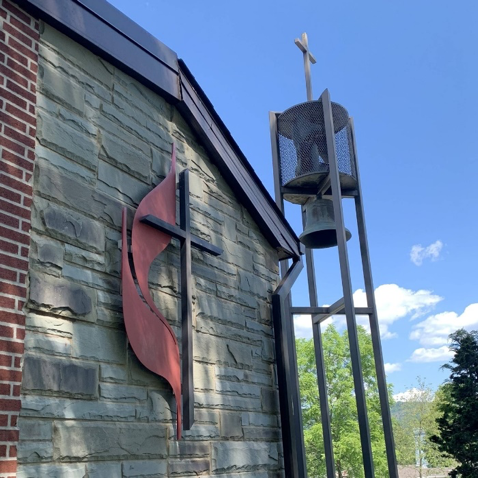
Besides these precious items, there were numerous Memorial Gifts that were presented at the consecration ceremony:
Pulpit Chair – in memory of Alvin Stair by Mrs. Stair
Pulpit Chair – in memory of Alvin Stair by M/M Leo Luchi
Pulpit Chair – in memory of parents by M/M Leon Buffington
Lectern – in memory of Robert Wolfe by family & friends
Pulpit presented by Dr. & Mrs. Wayne Turner & daughter, Mollie
Piano – in memory of Frederick Kraft by Mary Kraft & Beverly
Bell Tower housing the church bell - in memory of Mrs. Anna Mae Woodring by M/M Michael Kuchar & M/M Thomas Burns
Organ donation - by M/M Harold Welsh for their loved ones
Carillon System - presented by M/M John Gould
The cornerstone for the new Sanctuary was laid in 1982 in a ceremony lead by Dr. Burns Brodhead, District Superintendent. Those members of the congregation who took part were:
Michael Kuchar, Lay Leader; Roland Wolfe, Board Chairman, Debbie Rowett, Flutist; Jacque Wetzel, Organist; Roland Wolfe, Usher; Stephen Zanoline, Usher; Russell Croman, Usher; and Robert Wolfe, Usher. Kevin Woodeshick, Acolyte; Marion Oberst, Greeter; Jane Tredinnick, Greeter; Administrative Board Members: Rev. Martin Morgan, Jr., Pastor; Mildred Hopkins, Conference Lay member; Ellen Glassbrenner, Charge Treasurer; Nancy Lamana, Recording Secretary; Nan McNeal, Financial Secretary; Thelma Pentz, Treasurer; and Rose Welliver, UMW Representative.
These early historical years of Methodism in Conyngham reveal great sacrifice and deep devotion to God. From the time of John Wesley through the years of the circuit rider, in the early American wilderness, down to the present day, the Methodist Church has been recognized as one which seeks to meet the needs of people and society.